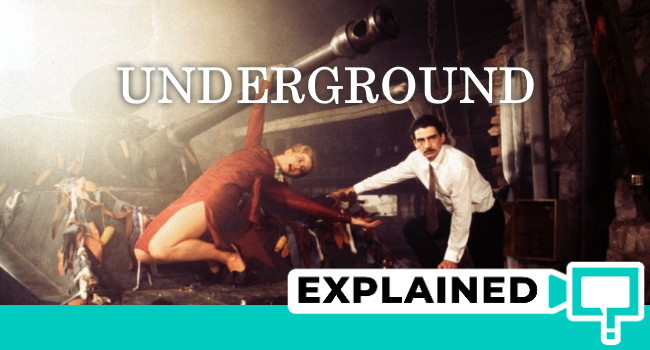Underground is a 1995 movie made by an acclaimed director Emir Kusturica with a screenplay co-written by Dusan Kovacević. It won the Palme d’Or at the 1995 Cannes Film Festival, which makes it one of the best internationally recognized pieces of Yugoslav cinematography. The music is made by Goran Bregović, arguably the most internationally renowned musician from the region, who also worked on the movies like La Reine Margot and The Serpent’s Kiss.
The movie is often described as a masterpiece, not just because of the skillful directing and an amazing cast but also because it used something not seen often in cinematography – magical realism. Here’s how Kusturica made all of this work.
Hollywordle – Check out my new Hollywood Wordle game!
Where To Watch?
To find where to stream any movie or series based on your country, use This Is Barry’s Where To Watch.
Oh, and if this article doesn’t answer all of your questions, drop me a comment or an FB chat message, and I’ll get you the answer. You can find other film explanations using the search option on top of the site.
Underground Movie: Brief Synopsis
The story follows two best friends, Petar Popara Blacky (Blacky) and Marko Dren. The two of them are smugglers and burglars who engaged in these illegal activities in order to financially support the communist insurgency in Yugoslavia during the early days of World War Two.
The wife of Blacky dies in childbirth during one of the German air raids, and after a brief mourning period, he decides to remarry to an actress Natalia, wooed by a German officer Franz. Blacky and Marko storm the theater and kidnap Natalia, pursued by the German forces. Blacky and Natalia marry on a boat (with Marko as his best man), only to be surrounded by the Germans a couple of moments later. Blacky is captured and tortured by the Wehrmacht forces until he is successfully saved by Marko.
In a semi-comatose state, Marko places Blacky in his underground bunker/ammunitions factory. Seeing how he has fallen in love with Natalia, he decides to keep Blacky (and others who sought shelter there) in the basement by feeding them false information. Even two decades after the war, he is still recording false news about German advances in the war, simultaneously keeping Blacky underground and exploiting them to work in his arms and ammunition factory for free.
The whole situation untangles quite tragically, and various elements of the story closely mimic the breakup of Yugoslavia.
What Is Magical Realism?
The best way to describe magical realism would be to say that it’s a portrayal of a world in which fantastical occurrences have a realistic tone. For instance, in a Gothic novel, if a ghost was to appear during a family dinner, everyone would run out of the room screaming. In a novel containing magical realism, someone would just politely ask the ghost to pass them the salt.
As a genre, magical realism is not as common in cinematography, making Underground even more unique. The most famous examples of magical realism in literature can be seen in the works of Marquez and Rushdie.
Social commentary through magical realism: Too gritty for realism
There are several reasons why Kusturica decided to use magical realism for this work. First, trying to depict themes of World War Two or the breakup of Yugoslavia through realism would always give a gritty (sometimes even nauseating) result. These gritty elements sometimes seem so intense that they steal all the attention from the plot and even the messages that the artist was aiming to send. Magical realism helps soften the blow and gives the story a comical undertone.
- For instance, the scene of Blacky’s torture would be disturbing if not for the fact that Blacky is actually immune to electricity (due to many years of him working as an electrician before the war).
- The same goes for the scene of the bombardment of Belgrade. The scene would otherwise be tragic, but in the movie, it was made comical by the fact that Marko (a sociopath) gets sexually excited by the sound of the bombs.
To be completely honest, magical realism is not the only thing “softening the blow of reality.” As a proper cinematic masterpiece, Underground also uses dynamic, intense, and cheerful music. This is why the only way to fully experience this movie is with a proper setup. Seeing as how you’re unlikely to catch it in cinemas nowadays, your only option is to make a home theater with a great sound system and soundproof panels on the walls. This adds a new dimension to the viewing experience altogether.
Subversion of Utopia: Yugoslavia at Its Strangest
Another thing worth considering is that this movie achieved something incredible – it retold about 50 years of Yugoslav history in just three hours. To achieve this, the director strongly fixates on archetypes and symbols.
Blacky is the Yugoslav people, strong, resilient, and loyal to a fault, which makes it incredibly easy for Marko (an archetype of a communist intellectual elite) to exploit him. Natalia represents the opportunistic fabric of Yugoslav society, seeing as how she’s capable of switching sides several times during the same scene. Franz is an archetypical occupier (as seen through Yugoslav eyes) – incompetent and easy to kill, but he (somehow) always keeps returning.
The underground bunker represents Yugoslavia, sheltered from the outside world by being kept in the dark. Parallels to Plato’s Cave are more than evident here. The fact that people in the bunker are manufacturing arms is also symbolic, seeing as how Yugoslavia, at its finest, was one of the world’s largest arms exporters (especially proportionally to its size). In other words, they are people kept in the basement making arms.
One more thing worth mentioning is the concept of stolen time. You see, Marko’s grandfather (his insider in the bunker) steals 6 hours every single day in order to soften the blow of isolation and keep everyone loyal. This can be interpreted in many ways, but the strongest allegory here is definitely the one about Yugoslavs lagging years behind the rest of the world (in many aspects).
Meta Cinematography in the movie Underground
Somewhere in the middle of Act II, there’s a subplot going on about the movie being made. This kind of meta cinematography (a movie within a movie) is there to subvert the whole structure of pre-breakup Yugoslav cinematography.
Namely, the movie being made is the one based on Marko and Blacky’s wartime exploits. Now, Underground itself (being magical realism) is deliberately made to be ridiculously unrealistic (Blacky being hyper-strong, immune to electricity, perhaps even bullets), but the movie within a movie goes even further. It’s a parody of Yugoslav partisan films, where heroes are killing Germans in droves (sometimes scores, with a single hand grenade). Of course, here, the movie takes an absurdist approach to the whole concept.
The actors themselves (chosen to represent Blacky, Marko, Natalia, and even Franz) are actually played by the same real-life actors (thus taking double roles in the movie). In a way, this is the director’s commentary on the phenomenon where life imitates art instead of it being the other way around.
Lastly, there’s a massive segment of real-life historical reels with Marko being edited in. This shows us that while this is an alternate history, the historical deviations in question are quite light (in the broader context of events). It also shows just how easy it would be to change history through various Orwellian means.
Underground Movie: In Conclusion
The best thing about Underground is not the use of all these elements individually but the way in which it all comes together. There’s no larpurlartism (art for art’s sake), seeing as how this is a concept that both Kusturica and his strongest influence Ivo Andrić (the only Yugoslav winner of the Nobel Prize in Literature), seem to despise. It’s a unique cinematic experience, as well as a piece sending a powerful message.
In other words, even those unfamiliar with the historical events in question have something to enjoy. Those who have done a bit of research, on the other hand, stand to gain much, much more.
What were your thoughts on the plot, themes and ending of the 1995 movie Underground? Do leave your comments below.

Stacey is a talented freelance writer passionate about all things pop culture. She has a keen eye for detail and a natural talent for storytelling. She’s a super-fan of Game of Thrones, Cats, and Indie Rock Music and can often be found engrossed in complex films and books. Connect with her on her social media handles to learn more about her work and interests.

